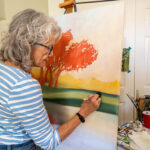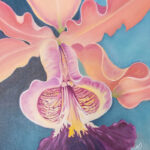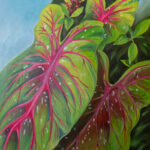
An independent thinker and artist, Mary O’Neal brings works of tranquility and gentle imagery into focus, capturing the viewers’ attention with such subjects as rare conch shells, fleeting butterflies with black and white racing stripes and exotic flowers.
“My mother, who will be 100, tells me that as soon as I could hold a pencil, I would be drawing whatever I saw,” says O’Neal. “And now I do the same with photographs and paint.”
Most recently, O’Neal’s painting “The Sea, Beyond” was one of the 63 selected to be included in the A.E. Backus Museum’s annual Best of the Best juried fine art exhibition, out of the 297 submitted.
“‘The Sea, Beyond’ was from a photograph I took at the Treasure Shores Beach Park access at Wabasso. The trees and view caught my attention, and I just knew I had to paint this scenic area.
I work from my own photographs, and they’re all done with an iPhone,” she explains.
Raised in Mims, Florida, O’Neal studied at Ringling School of Art, which officially became Ringling College of Art and Design in 1979.
“Ringling was then a three-year school and awarded certificates,” says O’Neil, adding that 10 years later she earned a BFA degree from the New York State School of Ceramics at Alfred University.
O’Neal worked mostly in watercolor when she moved to New York state. She also designed T-shirts and other fashions and began to work in clay. Her ceramic creations were decoratively hand painted, and included functional stoneware and porcelain. They were fired in her own kiln and sold at art shows, enabling O’Neal to support herself.
“I did and still do art for my own pleasure. I strive to enhance nature’s colors. I always did a lot of two-dimensional work. I used lots of vibrant colors, mixed media, pastels and a combination of the two.”
She describes her art process as abstract realism, taking from nature and embellishing it; transforming actual plein air vistas with the imaginative brush strokes of the artist.
“I create my butterflies and construct an environment for them, even place it on an entirely different flower. Initially I combine thumbnail sketches, but I eventually do a large butterfly just to see how it will work. I manipulate the colors and subject and use photographs as a reference and may eliminate the background,” says O’Neal.
The effect is lifelike; an almost living, breathing fleeting butterfly image captured on canvas.
After a trip to Sanibel, she returned with a bucket of treasured shells, inspiring a series of conch oil paintings – the queen conch, horse conch, horned queen conch and murex.
O’Neal has captured the minute details of the shells; their rugged edges and the curling inward of the curves, resting on the sand as if waiting for a passing beachcomber. A hint of surf and sky shows in the foreground, causing the shell to appear life size.
“When I did the conch shells, I took pictures of them and had some photos of the ocean used as a backdrop. The goal is to bring the viewer along on my perception of the world and how I want to see the world. It’s a bit fantasy-base but it’s not,” she explains.
“I paint one color across the entire canvas. It’s called an under painting. Whether looking at a photograph or if I’m doing plein air, I lightly sketch the forms and subjects.”
O’Neal’s understated manner of describing her process belies the mindfulness she puts into each painting.
Her self-confidence is evident in O’Neal’s “Three Faces of Diana,” a startling portrait in watercolor that affirms her sense of pigment saturation, determination and humor. The subject is a woman dressed in a bright tutu, carrying a pitchfork, and wearing an opera style helmet with horns.
She and her husband owned and operated a frame shop, during which time they attended art receptions and exhibits, before another door opened, a position with the home furnisher Rooms to Go.
“I did display and visual design for about 35 years. This offered a lot of artistic freedom with some standards. Staff weren’t allowed to place their own work in the rooms. The company sent us to the Japan franchises. We stayed in Yokohama, worked during the day then at night went sightseeing,” O’Neal recalls with a gleam.
Following her retirement, O’Neal, still an independent artist, became a board member at the nonprofit Isola Arts, founded by Katherine Larson. Abiding to the mantra of “Art in Unusual Places,” they held one of their first group exhibits at the “haunted” Tangelo Apartments building.
Built in the mid-1920s, it is said to have paranormal activities, and during building renovations, workers began to experience intermittent vertigo and heard strange creaking noises. Even the artists felt something strange about the building, but O’Neal and the others were pleased with the turnout, no doubt helped by the ghostly intrigue.
Soon after, Larson and Charlotte Tripson, great-granddaughter of Waldo Sexton, launched Waldo’s Secret Art Walk, weekends the first Friday through Sunday of the month at the Sexton homestead. Its winding stone-pebbled paths offer a unique place for O’Neal and other Isola Arts artists to showcase their work.
O’Neal and her husband of 31 years, a retired chemical engineer, enjoy reading, Florida summers, each other’s company, and staying engaged with nature, artists and the arts of Vero Beach.
She advises aspiring artists to “be yourself, stay true to yourself and don’t get influenced by whatever other people are doing. Do who you are.”
Photos by Joshua Kodis














